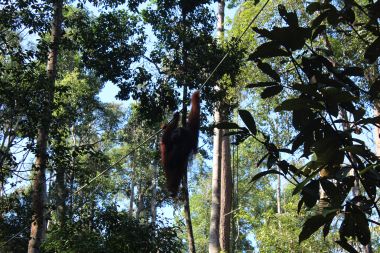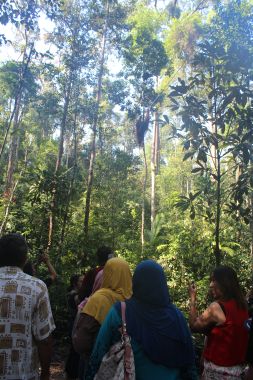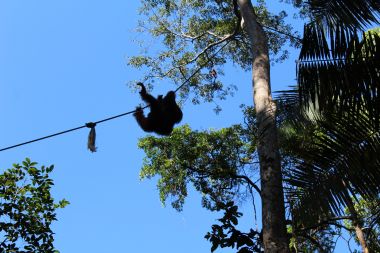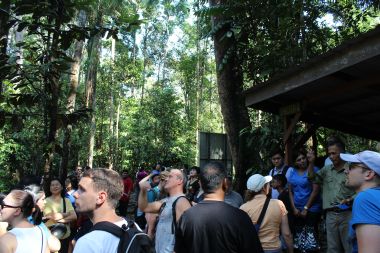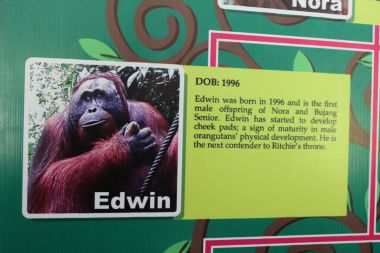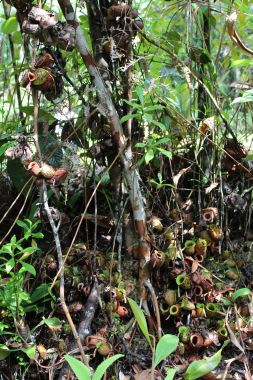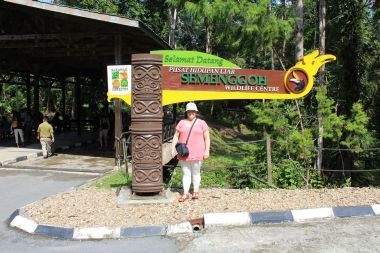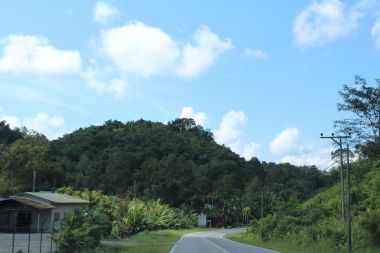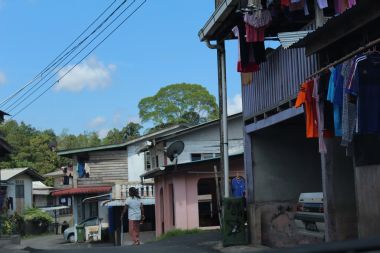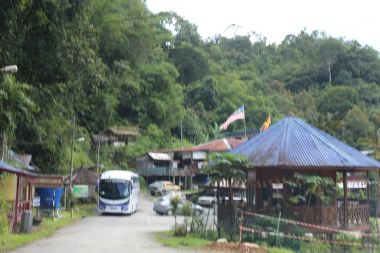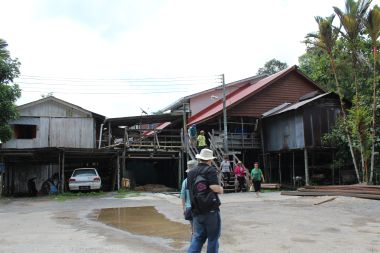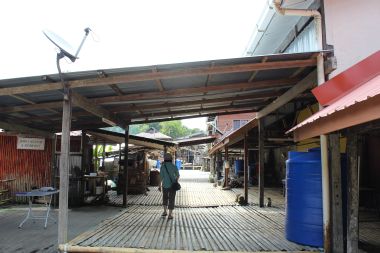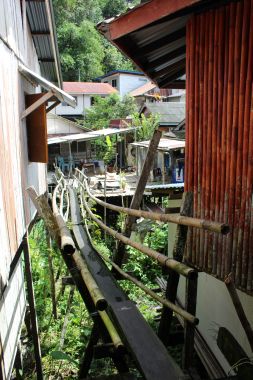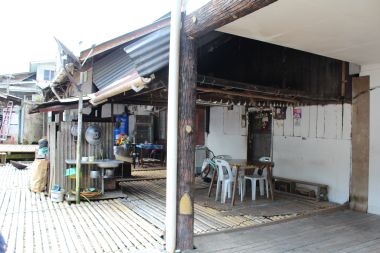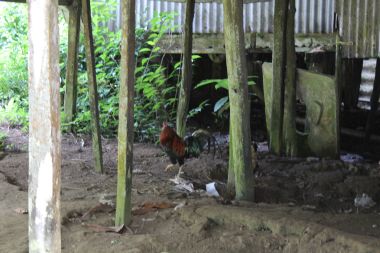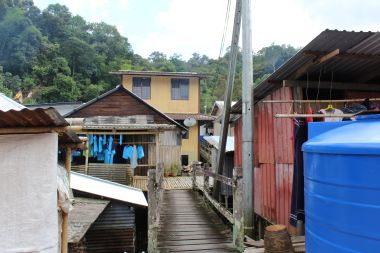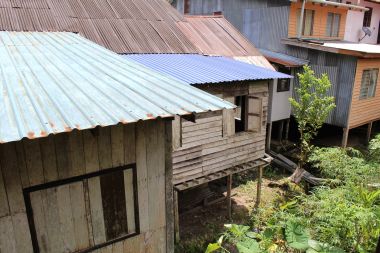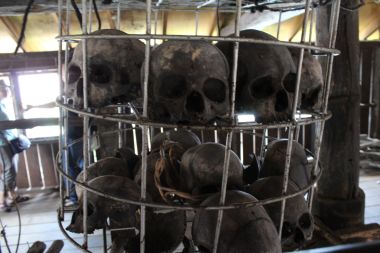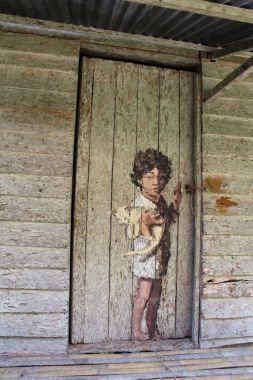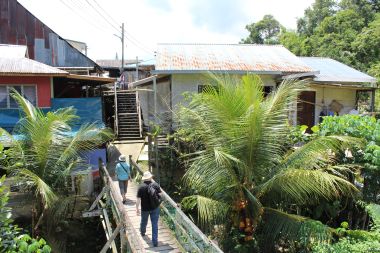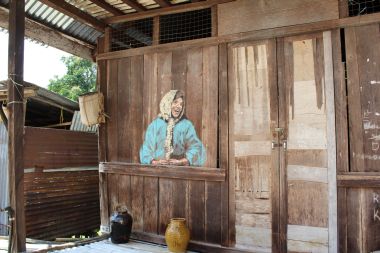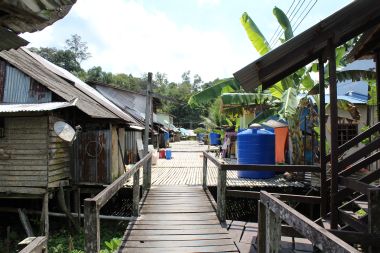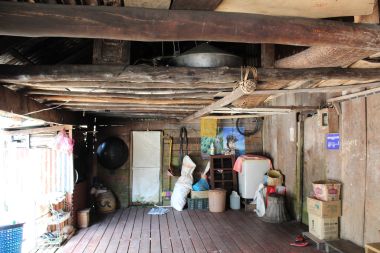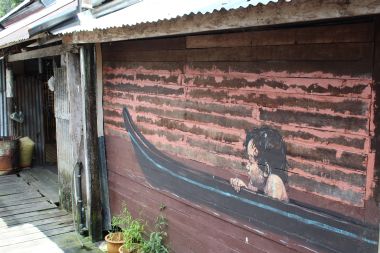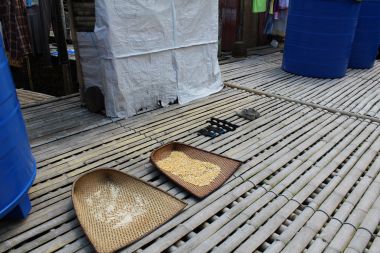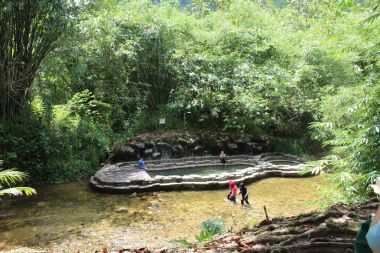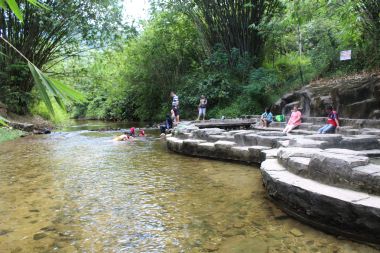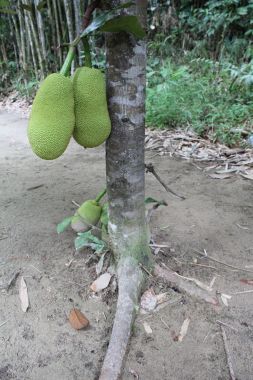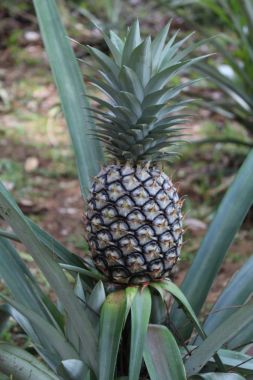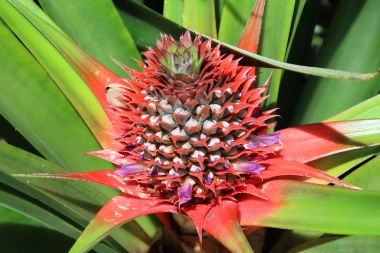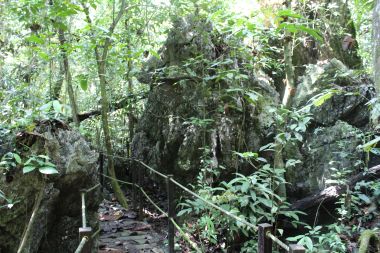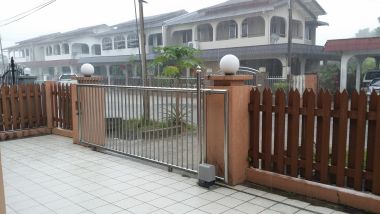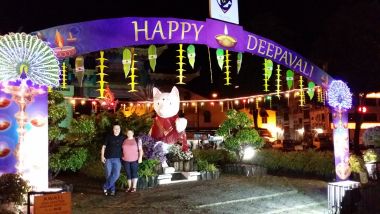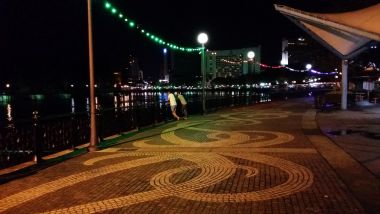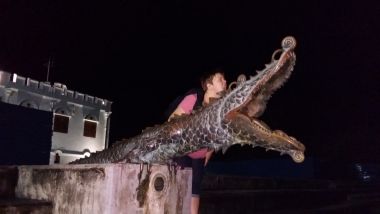Monday, November 9th
It was an early start this morning if we were going to catch the orangutans being fed so we reluctantly got up at 7 to have a bit of a shower then head out.
Sian wanted to take us to a small local restaurant for breakfast of handmade noodles. The utilitarian interior was like a step back in time with old pictures on the walls and slow service to match. Sian assured us it was worth the wait and about 10 or 15 minutes later we were rewarded with a small bowl of noodles topped with a bit of pork. The egg based noodles were perfectly cooked and the stock-based broth was rich and delicious. We stopped for a minute outside the shop where the cook was making them - expertly measuring out the noodles into baskets lowered into the cooking liquid. This is one of the oldest shops in town and they have never changed how they prepared the noodles…nor, it seems, have they have redecorated (!).
The “Semenggoh Wildlife Centre” is about 30 km from Kuching and is quite a popular place to visit. Every morning at 9:00 am you can go see the rangers in the sanctuary put out food for the orangutans. After finishing breakfast it was pretty close to 9 am…so we were in a bit of a hurry. We picked up our tickets from the main entrance then drove along a narrow, winding road until we were near to the feeding area. The parking lot was full so we parked on the road then, as per the directions of the rangers showing people around, quietly hurried to make it to the feeding area as we were told by the rangers directing traffic that the one orangutan that had showed up for food today was just about to leave. Mel was off in a flash - She loves wildlife and how often do you get to see one in their natural habitat instead of a zoo? Sian and I chuckled as we hurried after her along the rough trail through the forest until we came to a large crowded area crowded with people looking up - And there he was - A large male orangutan no more than 20 feet above our heads making his way along a suspended rope.
He stopped and had a look at us for a few minutes then headed up into the trees and away. It is amazing how quickly he was out of site.
Mel really was quite overcome with emotion drying tears from the corner of her eyes - It really was an incredible experience to see such a large wild animal so close up and an animal that is so like us. We were dripping with sweat from the run through the humid jungle but it was well worth it.
The ranger talked to us for a while telling us it was “Edwin” a large 19 year-old male orangutan that had come down today. This time of year there is lots to eat in the forest so many of the orangutan here do not bother to come for the food that is laid out. This is also the time of year when they give birth to their young so the mothers are quite protective and prefer to avoid the feeding area. He showed pictures of the various orangutans on his phone and explained about their habits and characteristics. Even though the sanctuary has no walls to prevent the orangutans from leaving they never have - They have it made here with protection and all the food they can eat - All they have to do is put up with the daily visits of tourists. Yesterday no orangutans showed up so we really were quite lucky.
Returning along the path we visited a small gallery (air conditioned - thankfully after the heat of the forest) with pictures and information about what they do in the sanctuary - effectively a sanctuary and rehabilitation centre for local wildlife with a speciality in orangutans.
A small enclosure held a few crocodiles that were ominously quiet…Mel didn’t spot several in the water until I pointed them out - They really do look like logs when motionless.
The water in the various streams around us was grey with sediment from the daily rains here. We took a number of pictures of the pitcher plants that grow throughout the jungle here. They are quite amazing looking plants…
Unfortunately, many of the trails around the sanctuary are closed otherwise we could have explored a bit more. Sian suggested it might have to do with some problems they have had with visitors disturbing the wildlife recently.
We made our way to the small gift shop where Mel picked up a hat that she was quite pleased with - a baseball cap type affair but well ventilated and with a piece of fabric that hangs down at the back on the neck. Anything to keep out the sun and heat…
Next up Sian drove us to the south to visit a longhouse - One where people actually live, not just a museum or tourist trap though it is visited by a lot of tourists as it is the closest longhouse to Kuching.
It is very close to the Indonesian border so we had plenty of time to take in the scenery even more so when Sian took a bit of a wrong turn and we ended up driving through a small town. It turned out to be an interesting thing anyway as the narrow and largely unmarked streets had houses built right up to the road. Amusing as we passed by a lady looking at us a bit odd then when we ended up at a dead end and passed her again on the way back out…she must have thought we were crazy!
Annah Rais Longhouse has so many visitors that the villagers living there started to charge admission. All money they make goes into the village and it is run by the villagers themselves. The longhouse is accessed straight off of the car park with a series of steps leading up to the elevated village platform make of creaking bamboo. The village is in the middle of valley surrounded on all sides by mountains covered with green vegetation. Very peaceful. Except for the occasional tourist…
It was the heat of the day so there were not many people outside but the traditional rice wine was offered to us (free, of course) as we entered the complex. I, being a non-drinker, declined but Mel tried some and said it was quite nice.
The initial main section of the longhouse is about 20-25 meters across with homes built on the left and right. Part of the main “street”, outside the houses, is covered by an overhang to keep out the sun and heavy rains. Doors lead off this into people’s houses with some of them being actually available to pay to stay in if you want the full longhouse “experience”.
On the right was a lady with a set of tables set up on which she had various hand-made souvenirs for sale. We sat for a few minutes to have a cold drink sitting in some sofas and chairs that had seen better days. She laughed as we sat down “Why not sit on the other side where you can feel the fans?” Talking to her further she said her mother ran a “museum” in her home just opposite where we were sitting but, unfortunately, she was not in today. Mel took a picture of the cat and her kitten sitting on the front step instead.
The houses are mostly made of wood with corrugated iron roofs. There are windows but many do not have any coverings or even mesh to keep out the insects. This is a real village so it is made for practicality rather than beauty so you see the occasional sheet of plastic to keep out the rain. Plastic lawn chairs here and there, weathered satellite dishes nailed to the walls, laundry hanging from make-shift laundry lines, pots for various uses, chickens scratching in the dirt…everything you might expect to see in a village.
There are large blue plastic cylinders outside of many of the houses. Sian told us that these are water butts provided by the local council to the locals for them to capture rain water - To encourage this eco-friendly way of getting water.
As you walk along the longhouse “roads” you can see through the bamboo to the ground about 10-15 feet below. Occasionally you glimpse a chickens that they generally keep below the walkway (Mel took more pictures).
We visited the main hall and it was largely like what we saw yesterday at the cultural village - A small square room with a fire pit in the middle and a cage above with the skulls of the hunters that had passed on leaving their spirit here in the heart of the community.
A local artist was invited by the village to paint some murals which you spot throughout. A small child here and elderly woman there. They are uncanny in capturing the character of the people they depict - Very well done and fun to spot in unexpected areas.
The longhouse is not simply a single platform with houses off of it - There are narrow walkways leading to other areas at lower and higher levels. At one point we crossed over a modern concrete bridge above a river swollen with the water of the daily rains to arrive at the far side of the village which is even quieter, if that is possible, than the main part we had visited.
As we walked along the porches outside the houses occasionally we would spot a resident and respectfully greet them - They were very friendly and laughed as Mel took pictures of the ever-present scrawny cats.
On a part of the bamboo road they some rice laid out in the sun to dry - It is not the long-grain rice you might be used to. This rice is grown not in the water-soaked paddies you see in other parts of Asia but in drier patches of dirt that are everywhere - We saw some in tiers up the side of a mountain. The rice is traditionally not husked so reminds me a lot of the wild rice we get in Canada. So probably pretty woody too…
It was an incredible place to visit. It seemed almost unreal though it was obviously very real and very much a place where people lived. Incredible to think that these places still exist. I remember Sian telling me yesterday that there are many places in Borneo where people live that cannot be accessed by road OR air so you have to basically hike to them. Complete areas of Malaysia you cannot drive into at all.
A rickety wooden bridge led from the village car park up a wonderful new road that we followed to visit the Air Panas Annah Rais (“Annah Rais Hot Spring”; http://www.annahrais.com.my/). After Sian paid our admission fee at the hut at the entrance we followed a concrete path winding it’s way past pineapple and jackfruit plants. The path ends at an incline where you can look down at the hot springs - in the middle of a stream. A small covered area to the right has changing rooms and picnic tables set up which were quite busy. We walked down a winding dirt track to the water. A few children were loudly playing and splashing about in the water while others were sitting with their feet in the hot spring and just relaxing.
I have been wearing my heavy-duty sandals that I originally purchased for use in Africa and that have served me very well. I waded straight into the fast moving cool stream which was very rocky across to the far side where there was an area separated from the stream by a small concrete and rock wall. It was here that the hot waters bubble up from the earth and you can sit and soak your feet in the quite warm waters. I sat down for a few minutes waiting for Sian and Mel to join me - It took them a bit longer as Mel did not have sandals she could wear in the water so had to painfully walk barefoot across the rocks to the spring.
Of course, never one to sit still for any longer than 2 or 3 minutes, I quickly got bored and saw about 100 m further down a smaller hot spring right in the middle of the stream. Though the water was quite a bit deeper I made my way to it to see how hot it was. It was much smaller, only about 2 m across or so compared to the 10-12 m by 5 m of the first pool. They said it was hot enough to cook rice and after dabbing my foot in it, I believed them! Extremely hot and I pretty much scalded myself in the half second my foot was in.
One might wonder at spending some time soaking our feet in a hot spring when the temperature where we were in the jungle was probably in excess of 36-38 Celsius with 80% or more humidity. Fair point. It does seem a bit silly doesn't it?
Along the path back to the car we stopped to admire the fruit growing alongside…
The return trip to Kuching should be about 70 km but when Sian got to a fork in the road she asked us if we wanted to take the quick way or the more…meandering…way. No question, we took the scenic route. It turned out to be a very windy, up and down trip through gorgeous, lush, green scenery. Very few people.
At one point, Sian stopped the car beside the road - She had spotted a sign. It was a sign indicating that the area was home of the Malaysian “Corpse flower” (Rafflesia), a large round ground flower that is purple with white spots and smells like rotten meat to attract pollinators. It only flowers very rarely - something like 6-9 months after germinating (then dying). This is not to be confused with the “Amorphophallus” which is also called the “Corpse flower” but has a very tall central white shaft. Anyway, Sian thought it would be worth stopping to see if we could spot one of the Malaysian version…So we opened the gate and followed the elevated wooden walkway into the woods. At times you could not see the path as it was covered with so much debris and at one point we even had to duck to avoid smacking our heads into a tree branch growing across the path. At the end there was a viewing platform with some signs - We had obviously reached where the flowers should be we spent a good five or ten minutes looking around to see if we could spot them. No luck. But it was quite interesting to be alone in the middle of what was basically jungle.
Ever concerned that we were not starving (!) we stopped just outside of Kuching for a bite to eat at a small hawker market just beside the road that was obviously used by a lot of travellers. Still no funny looks from the locals as we tucked into some steamed dim sum-style dumplings, various pieces of barbecued pork, steamed buns and a bowl full of delicious chicken broth. Another delicious meal and probably did not cost us any more than £3 each…We will never know since Sian paid for it again. She is such a good host to us.
We were just in time to get back into the car as the rain just started coming down so hard at that point it was difficult to see out of the windows driving back into the city. Amazing and I find it fascinating - quite relaxing. You just don’t see this kind of rain in London. When we got back to the house I laid on Sian’s sofa and opened the door to watch.
Mel and Sian wanted to get a massage so we visited a local Malaysian massage parlour. It was not the fanciest but Mel told me it was a very good full body massage. Sian had a foot massage and I sat in a chair beside her and read a book. I am not one for massages. It was nice though because they brought me some herbal tea to sip on while I was waiting. Very peaceful sitting there with a waterfall feature in the corner decorated with plastic plants and flowers - The sound of the water. The massage place is opposite a Sikh temple that I was considering visiting until I realised it was just before 6 pm and I was told it was closing at 6 pm. Oh well, I read my book instead.
For dinner Sian wanted to take us to a restaurant serving very local Malay food. Up to this point we had been trying food that was from other cultures that have settled here but we had not yet tried true Malay food. The restaurant is called “Lepau” and it is an open wooden building decorated with traditional crafts and having simple furniture. Finding a table at the corner the kitchen was behind a curtain beside us. I can’t really remember the names of things so let me describe them to you: The same fern greens (“Midin”) we had last night but this time in shrimp paste (we did not like this as the paste is way too strong and fishy but as Sian said: We needed to try it), a fish dish, sticky rice wrapped in lotus leaves (like what you see in Chinese cooking), and a very fishy tasting rice. I had a glass of delicious fresh fruit juice but Mel had some root beer - Taking advantage of the fact that they seem to have A&W pretty much everywhere here. We managed to grab the bill before Sian though…
Up until now we have not really seen one of the few things that I wanted to see when I had done a bit of reading up on Kuching, the old town. Sian drove us through the gate leading to the old town where she parked. We got out of the car to have a look at a colourful display for Deepavali which is only a few days away - A display that featured the town mascot: The cat.
Then a stroll along the river…As with many towns, in the past there were warehouses all along the river here but they have since been torn down to make way for gardens and parks, in this case populated with modern sculpture, large palm trees and, to our eyes, exotic plants.
The walk was quite pleasant looking at the cone-shaped legislature building lit up on the far side as well as a new elevated walkway on the river that follows the shore. The river was still fairly busy with garishly lit tourist boats occasionally passing but we did also spot some smaller more traditional boats that Sian told us they used to use to cross the river - About 8 m long covered boat with a small engine at the back. Away from our walk along the path through the park we could see the fronts of the shops of the old town facing us. Well, as it was late we would not be visiting them tonight.
To be fair Sian has been asking us about whether we needed any washing done and given that we are both sweating so much we should have taken her up on this earlier but we only gave her some clothes to wash tonight. I am not sure they will be dry before our flight tomorrow afternoon…
